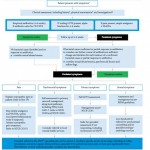Editorial: Chronic prostatitis – how to give our best without apposite vagueness
A patient with chronic prostatitis poses a significant challenge to the urologist in everyday practice. We are certain that all readers will be familiar with the effort required to manage a man with chronic prostatitis, not only in diagnostic and therapeutic interventions but also personal and psychological support. This is particularly true, when you consider that chronic prostatitis affects men of all ages and can significantly impair their quality of life and social functioning. Starting with medical considerations, the symptomatic, chronic forms of prostatitis, as defined by the USA National Institutes of Health (NIH) are chronic bacterial prostatitis (CBP; NIH category II) and chronic prostatitis/chronic pelvic pain syndrome (CP/CPPS; NIH category III) [1]. These chronic conditions present with a wide range of clinical manifestations, but the four main primarily recognised symptoms are: urogenital pain, lower urinary tract symptoms (voiding or storage symptoms), alteration of the psychological status, and sexual dysfunction [2].
Prevalence rates are estimated at 2–10%, with some as high as 15–16% in Asian, European and North American samples [3]. Both CBP and CP/CPPS present with no one identified underlying cause, although infectious, genetic, anatomical, physiological, neurological, and immunological factors may be involved. For whatever reason, the underlying factor(s) of chronic prostatitis are likely to trigger tissue inflammation and immune responses which, in turn, induce bladder and pelvic pain leading to LUTS, ejaculatory pain, and pain in other regions, including the lower back and abdomen. The lack of a distinct aetiology has made making a specific diagnosis and effectively treating the disorder very arduous, presenting a serious challenge to urologists. In this respect, the difficulty for us is to do our best in trying to solve the problem, without apposite vagueness! [4]. In the obscurity of actual knowledge about the pathophysiology, diagnosis and treatment of CBP and CP/CPPS, it seems that recent insights can be favourably identified.
The consensus guideline on the diagnosis and treatment of chronic bacterial prostatitis and chronic prostatitis/chronic pelvic pain syndrome, published in BJUI by Rees et al. [5], indeed represents an important tool to provide guidance to urologists and healthcare professionals treating patients with CBP and CP/CPPS. Starting from a literature review of the most updated evidence-based information in the field of CBP and CP/CPPS, the consensus guideline provides new and useful recommendations in signs and symptoms evaluation, and clinical assessment and diagnosis of CBP and CP/CPPS. In this regard, reliable instruments, e.g. the NIH-Chronic Prostatitis Symptoms index (NIH-CPSI), IPSS and UPOINT (Urinary, Psychosocial, Organ-specific, Infection, Neurological/systemic, and Tenderness) scales [5], have been suggested to assess initial symptom severity, evaluate phenotypic differences, and monitor patients’ response to therapeutic intervention. In addition, psychological screening to evaluate the presence of psychological disorders, e.g. depression and anxiety, has been strongly recommended. What is most important is the detailed information about treatment approaches for each individual patient, according to history, physical examination, investigations, and stage of the disease. Specifically, levels of evidence and different recommendations are provided for α-blockers, antimicrobial therapy, phytotherapy, and pain management. This guideline also has the merit of being simple and easily understandable for non-specialists and patients in showing the most appropriate way in following a patient with CBP and CP/CPPS. We are sure that this consensus guideline represents a step forward to a more adequate approach in diagnosing and treating patients with chronic prostatitis. It can be a tool to improve awareness and recognition of these conditions, and for uniformity among different specialists involved in the field.



